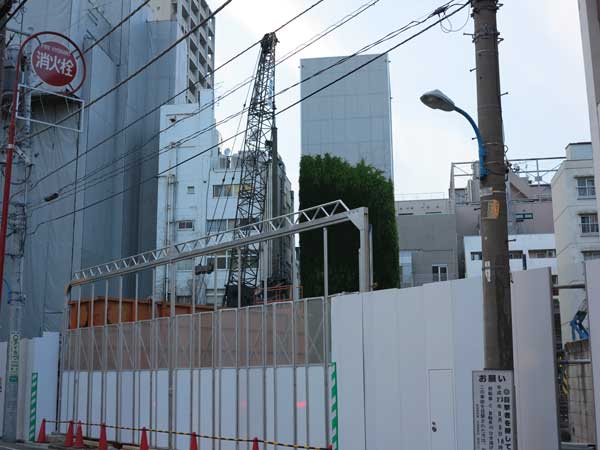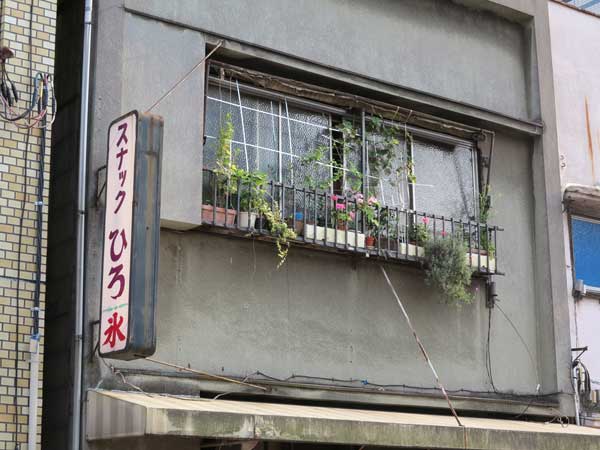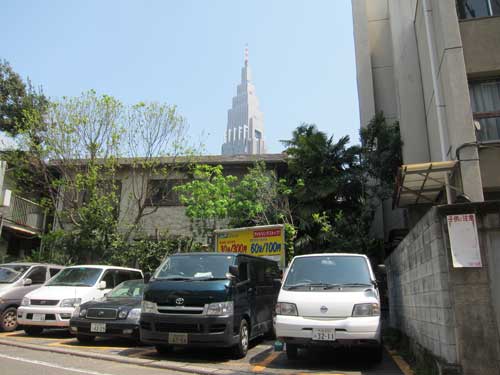
東京に戻ってきたとき、マンションの10階の足場は舞台裏みたいです。
This is how the balcony and former view looked when I returned to Tokyo. The extremely tidy screen, modified for a typhoon in fall, and the constant stream of workers make me feel that I am living on a stage set.

海外の日本庭園についての新しいサイトが立ち上げになりました。このサイトには、アフリカからロシアまで、何百もの日本庭園が紹介されています。サイトのスポンサーは著名な専門家である東京農業大学の鈴木誠教授です。日本庭園は生きた芸術作品であるため、地域社会との継続した様々なサポートが必要です。きれいなサイトデザインとロゴは、イアン・リナムさん(Ian Lynam)のおかげです。よろしくお願いいたします!
I am very pleased to announce a new website that provides scholarly and general public information about the hundreds of Japanese gardens outside Japan. This project puts online the database of Tokyo University of Agriculture’s Professor Makoto SUZUKI, the world’s expert on this unique Japanese cultural export. There are Japanese gardens in six continents, in conditions ranging from arid Australia to urban Brazil. I hope that my blog readers may have the opportunity to visit one of these living art works near where they live or travel.
A special thanks to the incomparably talented Ian Lynam, who created the visual design and the logo for the new Center for International Japanese Garden Studies.



Just looking at this parking tower covered in thick ivy makes me feel a little cooler. I wonder what creatures might be living inside.


I love the simplicity of this window garden in an old snack near Hamamatsuchou Station, an area better known for sleek new office towers and a port. In almost no space at all, this garden has climbers like bitter melon, pink flowers, herbs, and plants trailing down. It seems like the Hiro snack bar has been long out of business, yet someone is still enjoying living upstairs.


I like how this very common and hardy camellia brings some life to a concrete patio in a Nakano back street. I wonder who placed it there and keeps it well pruned.
I can easily imagine a jungle growing between these older commercial buildings, a living food alley with scent and maybe a small creek bed. As it is now, this space between buildings functions as a giant chute for capturing rainwater, which then travels many kilometers and must be processed, alongside sewage, before being released into Tokyo Bay.
At least someone working or living there is decorating and enjoying the space.

I love how these traditional Japanese pines in Shinjuku Gyoen are so meticulously pruned. On this clear winter day, I love how you can see the pine needles accumulating against the brown lawn. Three ladders, red traffic safety cones, helmets, and no doubt some great pruning shears.

「東京は人間のための都市(まち)に向けて変容していけるのでしょうか。」週末に、『家の外の都市の中の家』という展示会を見ました。新しい社会条件に、東京の建築家が創造的なアプローチをします。人間が都市で一番な要素であれば、その都市はどんな風に見えるでしょうか。他人を認識することが良いことならば、住宅はどのように変わるでしょうか。建物と建物の隙間が、建築物と同じくらい大事ならば、都市生活はどう感じるだろうか。時間があれば、10月2日まで展示会をご覧ください。
“Tokyo seems to be changing into a city that is meant for people,” concludes the introduction to the Tokyo Metabolizing exhibit at the Tokyo Opera City Art Gallery. The exhibit combines models and ideas from three architecture firms, Atelier Bow-Wow, Nishizawa Ryue, and Kitayama Koh, and formed part of the 2010 Venice Biennale.
Tokyo Metabolizing provides context for the rapid development of the world’s largest mega-city, and suggests new ways of living well in the city. I like how the architects respond with new dwelling types, including a blending of home and office, residences that share common spaces, and apartments where connectedness with others is valued more than privacy.
The architects are responding to new realities of who we live with and how we want to live. In Tokyo the average household is less than 2 people, and these smaller households seek new connections with neighbors, colleagues, and friends. I think the most radical suggestion is that an awareness of other people living around you might be considered a positive feature rather than something to be concealed or suppressed.
The metabolizing title harks back to a radical modernism from 1960s Tokyo, and foregrounds the city as a living organism: with a life, history, and progression. Carolyn Steel, in her book Hungry City, uses the concept of the city as an organism to focus attention on urban food delivery, prep and consumption. The urban built environment is also reflection of social life– from tax policy to demographics– and human aspirations.
I liked that Atelier Bow-Wow focuses on the untapped value of Tokyo’s void spaces: in-between, often wasted space between structures, which have potential for re-use and for gardens, community, and nature in the city.
The exhibit has great scale models, and is at Opera City until October 2. Also worth seeing is a special exhibit of recent works by young artist Ishii Toru (石井亨). Ishii creates psychedelic contemporary fantasies– full of convenience stores and fast food logos– using a traditional yuzen method of dyeing fabric.

この代々木の写真には、風景が3つ見えます。この組み合わせはとても東京らしいです。
This image sums up my love of Tokyo green spaces. In the background is the iconic Docomo Tower in Shinjuku. In the foreground is a typical Tokyo sight: a lot where the old structure has been raised is now used for hourly parking. In the middle is an older residence whose wild garden is thriving through neglect and the absence of redevelopment. Tokyo is a dense place full of the iconic and prosaic, living nature and concrete structures, traces of the past and constant change.

Tokyo’s great transit system allows you to go many places without a car. You can enjoy the scenery and meeting many people.
電車がたくさんあるので、車なしでいろいろな所へ行けます。多くの人に会えるし、きれいな景色を楽しめます。
The days are getting shorter, and with clearer skies the sunsets are remarkable. Recently I have been enjoying the views from elevated trains and stations. Trains in Japan are always punctual, clean and efficient. And apart from peak commute times, you can relax and enjoy the peacefulness of leaving the driving to others. Tokyo’s superior urban transportation system allows for a city where private cars are not the main form of mobility. It is still surprising to me how much walking, biking, conversation, playing, and reading dominates Tokyo’s many small streets, with the occasional car slowing down to pedestrians’ pace.


I attended a morning lecture at the University of Tokyo about landscape planning by Harvard Graduate School of Design professor emeritus Carl Steinitz. Many wonderful examples of Chinese, European and American large-scale landscapes, and a sense of continuity with Professor Steinitz’s professor and mentor, the illustrious urban planner Kevin Lynch.
My perspective on urban planning is far removed from lofty discussions of master plans. In my mind, Tokyo is a living city despite poor planning and governance. Those who believe in planning from above have difficulty in conceptualizing or benefiting from the enormous energy and capability of ordinary residents.
Leaving the lecture and on my way to a student cafeteria curry lunch, I was thinking these thoughts when I was struck by the autumn light against the mature trees and the shadows against the early 20th century brick buildings. There was a slight stench of ginko fruit. What a prefect visual and olfactory moment.
This week I have been very fortunate to hear several lectures by architects, urban critics, and landscape designers, including events at the Norwegian Embassy and Mori Building. It’s great to recognize so many talented people focused on urban environments and living with nature. I was also fortunate to share lunch with a Hitachi executive working on Smart City Business Management, a new division involved in global city projects. It was not surprising that he is a University of Tokyo alumnus.
Huffington Post published the English version of my article, “‘Do You Really Like Living Here?’ A Foreigner’s Perspective on Tokyo.”
“Do you really like living in Tokyo?” is a question I am often asked here. Despite living in Tokyo for two years now, I cannot discern if this question expresses national modesty, a sense of inferiority, or ignorance of the experience of daily life in the United States.
. . .
Read the full article on Huffington Post. It was originally published in Japanese by Newsweek Japan under the title, それでも外国人が東京暮らしを愛する理由 (Despite that, why foreigners enjoy Tokyo living) on October 28, 2010.

The New York Times ran a great story about how a small town in northern Japan named Inakadate has been creating art works using colored rice as a way to attract tourists and revive a struggling economy. Creating this living art work has brought the community together and draws up to 170,000 visitors to this town of fewer than 9,000 mostly elderly residents.
Five colors of rice plotted intricately on the field yield this image of a samurai fighting a warrior monk. The cost of renting and planting the field is about US35,000 making this an affordable rural revitalization effort. Last year 170,000 visitors came to view the rice art. And each year the town tries to outdo previous efforts to continue to gain media attention and visitors.

In May I spent a lot of time on my balcony garden: planting seeds, putting in starter vegetables (corn, watermelon, eggplant, cucumbers, and kiwi), planting herbs (basil, thyme, in addition to last year’s parsley), and adding new flowers and new types of fabric pots and coconut husk soil.

One aspect of my tiny garden I am enjoying are the flowerpots I made at Shiho ceramic studio last year. My theme for the ceramics was geometric shapes in terms of the pots and the glazing. I chose neutral colors so that the flowerpots would not distract from the plants.
Because the apartment is so small, the garden becomes part of everyday life. I see it from the kitchen table, where I often write on my laptop, and from the living room. With sliding walls, the garden is visible from the bedroom, too. Going outside is always just a few steps away.

Although I am a very amateur ceramicist, it is fun to have something you made yourself playing a big role in a small garden. There is something about the clay that provides an earthy feeling when you are in a high-rise with limited soil. I also like the contrast between the flowerpots and the cityscape beyond.

The San Francisco Chronicle quoted me about what California can learn from Japan’s high speed rail. Japan’s rail success is not just about traveling quickly between cities, but the convenience and efficiency of city transit and car-free living.